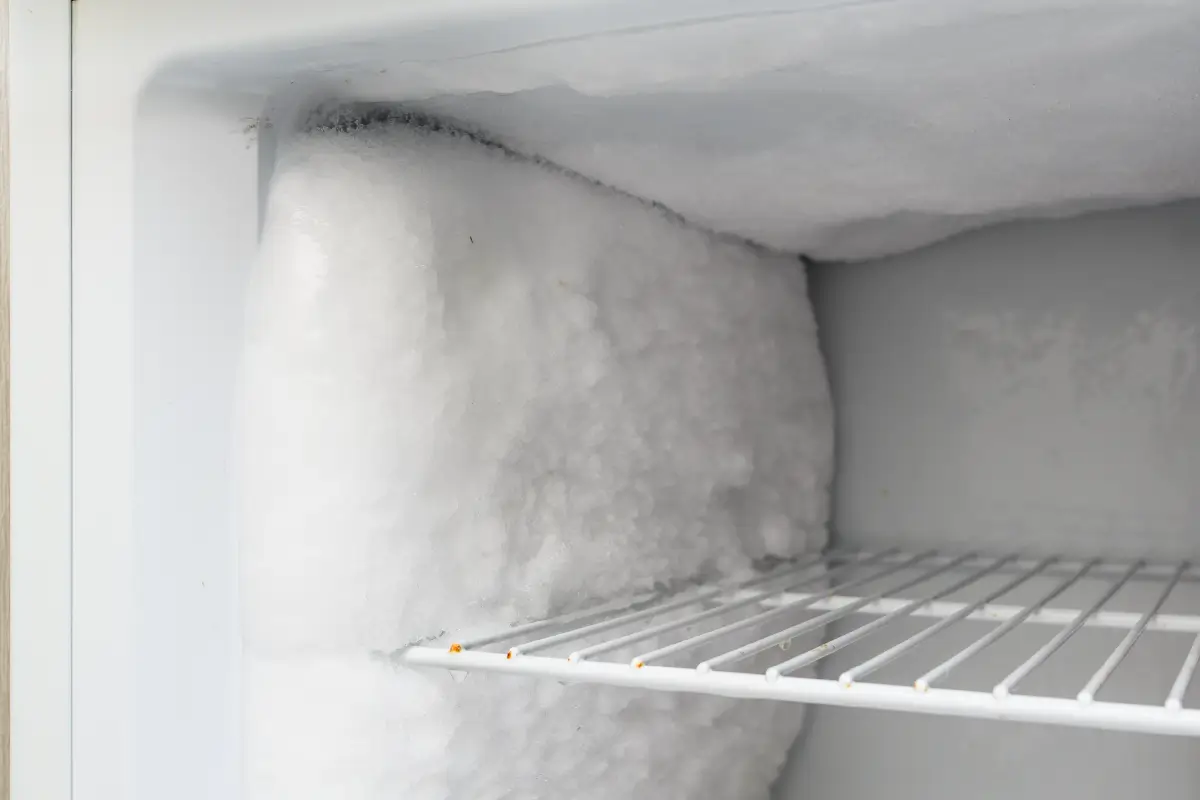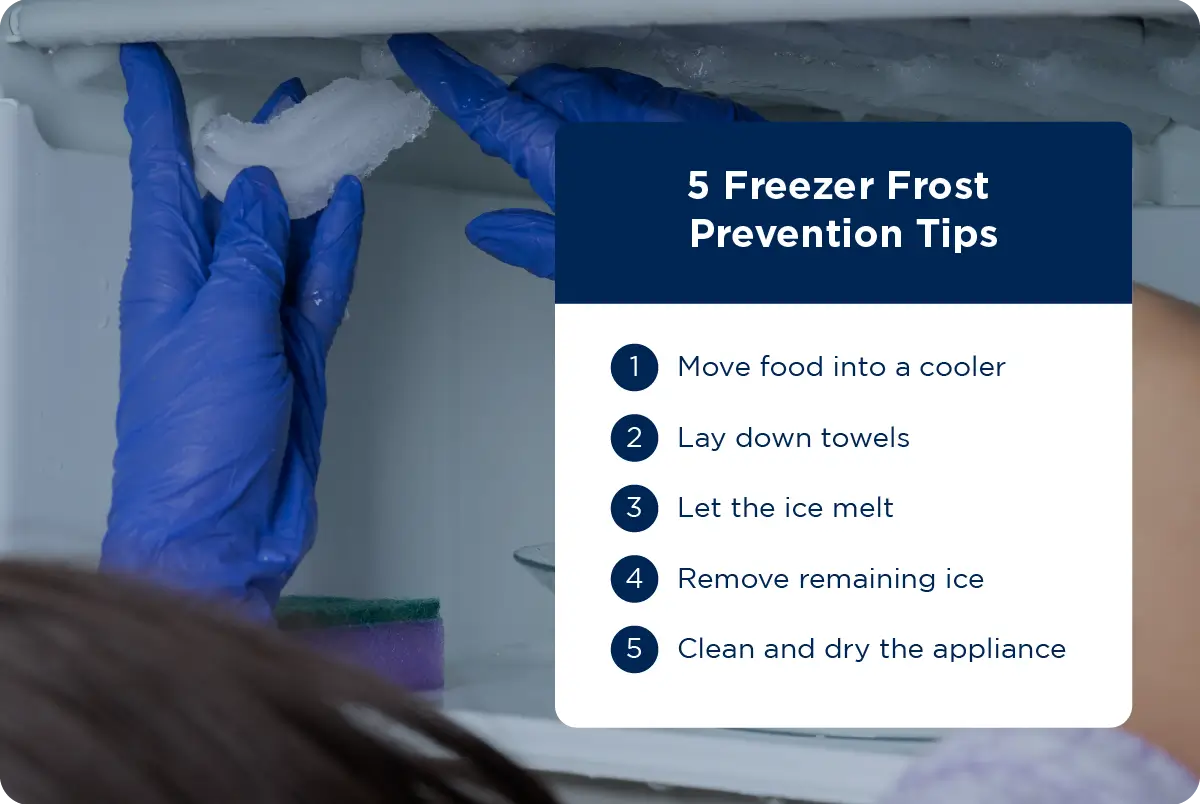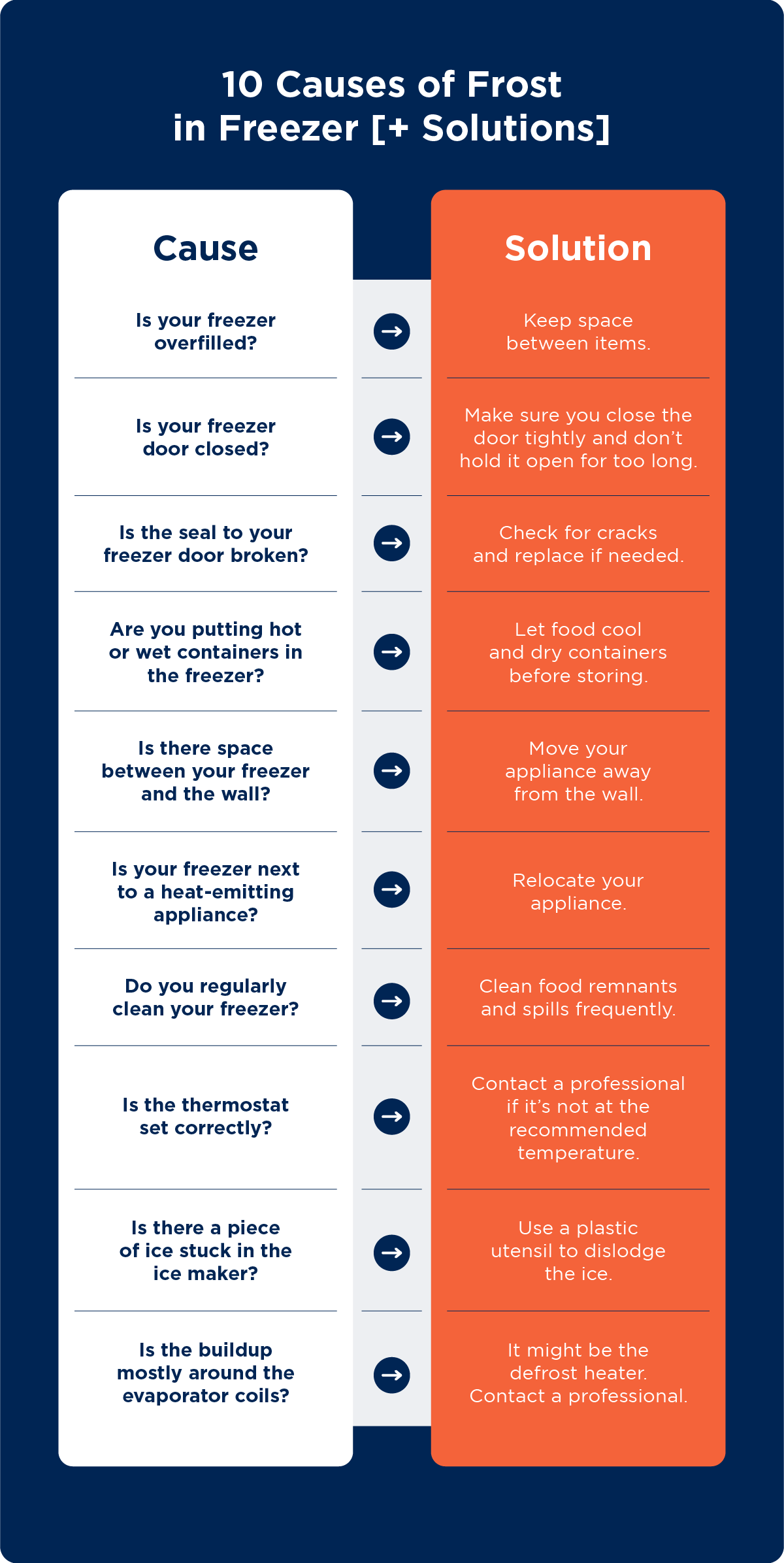Causes and Solutions of Frost Build-Up in Freezer

If your freezer looks like the inside of a snow globe, you’re probably all too familiar with the unpleasant smells, dreaded freezer burn, and even damage to your refrigerator.
Frost in your freezer can cause a lot of household headaches, but you don’t have to continue living with this unwelcome guest. Fortunately, it’s a common issue in older appliances that can be addressed with the right maintenance.
Keep reading to find out how to get rid of freezer frost, ways to prevent it from happening again, troubleshooting tips, and when it’s time to call in a professional.
1. Move Food Into a Cooler
Before you defrost your freezer, you should move all food from your freezer and refrigerator into a cooler. This precaution keeps your food safe from temperature fluctuations during the defrosting process. The last thing you want is your food to spoil while you address your freezer frost issue.
2. Lay Down Towels
Next, place towels strategically around and in the bottom of your refrigerator.
The towels will serve as a protective barrier to absorb any water or ice that melts while your appliance defrosts. They can also minimize the risk of potential slip hazards and damage to your kitchen floor or other nearby surfaces.
3. Unplug the Appliance
Once you’ve taken these precautions, unplug your appliance so your fridge or freezer stops generating cold air and goes into defrost mode.
This will allow any accumulated frost and ice to melt more quickly. Unplugging the appliance also prevents the risk of electric shock or damage to your appliance while you address the issue.
4. Let the Ice Melt
After unplugging your appliance, you’ll have to be patient and let the freezer naturally thaw. This step is vital, as forcibly chipping away at the ice could damage the interior of your freezer.
Letting the ice melt could take up to several hours, so leave your freezer door propped open and plan accordingly.
5. Clean and Dry the Appliance
This is a good opportunity to clean your appliance. Use a mixture of warm water and dish soap (or baking soda) to clean any lingering residue and eliminate odor. Lightly rinse with clean water.
After cleaning, thoroughly dry the interior of your appliance to prevent any future frost from forming. You may also need to dry the outside of your appliance if any water leaks out.
Once you’ve cleaned and dried your appliance, you can plug it back in and return your food to a frost-free freezer.
How To Prevent Freezer Frost
Preventing freezer frost is essential for maintaining the efficiency and longevity of your freezer. By following a few simple steps, you can make sure frost doesn’t build up and affect your appliances — and the food inside them.
- Keep the freezer door closed: Make sure to securely shut the freezer door each time you open it, and don’t hold it open for prolonged periods.
- Cool food before storing: Let your food reach room temperature before storing it in the freezer to reduce moisture content.
- Regularly clean the freezer: Food remnants or spilled liquids in your freezer can quickly crystallize into ice. Use a mix of warm water and baking soda to clean your freezer regularly.
- Don’t overload the freezer: While you may want to maximize your freezer space, leaving room between items ensures you’re not blocking air circulation.
- Inspect the door seal: Regularly check for cracks or gaps in the door seal and replace it when necessary to maintain a tight seal.
- Make sure the thermostat is set correctly: Find the ideal temperature for your model in its manual or online. Double-check the thermostat periodically to make sure it’s set to the recommended temperature.
- Ensure proper fridge placement: Leave space between the freezer and the wall, and avoid placing it near heat-emitting appliances such as furnaces, dryers, radiators, ovens, or water heaters.
What Causes Freezer Frost?
Freezer frost is primarily caused by the intrusion of warm, humid air into the freezer, and this can happen in many different ways. Here are some of the most common culprits of freezer frost and how to detect them.
Overfilling the Freezer
After a party or a holiday weekend, it’s normal to have more leftovers than usual end up in your freezer. But if the freezer is crammed too full, all that food prevents good air circulation.
As a result, every time you open the freezer door, warm, moist air settles on the frozen food and causes icing. To prevent this, avoid overfilling your freezer and make sure there’s room for airflow between frozen items.
Keeping the Freezer Door Open
Leaving the freezer door open, even for a short period, can lead to freezer frost. When warm, humid air from the room enters the freezer, it condenses on various items within the freezer.
Over time, this condensation freezes, resulting in a buildup of frost in your freezer. Be mindful of closing the freezer door securely after each use. It can also be helpful to organize your freezer to minimize the time the door is open while you’re searching for items.
Putting Hot or Wet Containers in the Freezer
Hot or wet containers cause an increase in your freezer’s humidity levels. Even with good airflow, increased humidity levels can cause frost to form on the sides of the freezer.
Make sure to allow hot foods to cool to room temperature before placing them in the freezer. Additionally, ensure containers are tightly sealed to prevent any moisture from escaping, and wipe down any wet containers before storing.
Gap in the Door Seal
If you notice frost forming around the door opening, the cause may be a faulty magnetic gasket seal (door gasket). This can especially be a problem in older refrigerators.
A simple test can show you the strength of your freezer’s door gasket. Clean and dry the seals, then place a strip of paper (a dollar bill is the right size and shape) halfway inside the door and close it. When you pull on the paper, if it slides out easily, then your gaskets aren’t sealing as tightly as they should.
If you’re a confident DIYer, you can replace the gasket seals. Order the seals from the manufacturer and follow the installation instructions. If you have any doubts about your ability to do this, contact an appliance professional to do the job.
Defective Ice Maker
If your refrigerator has a built-in ice maker in the door, warm air can enter the freezer through the ice chute. Not only can this cause frost to form in the freezer, but if left unchecked, it can also damage the ice maker.
Check to see whether a piece of ice is caught in the chute and preventing it from closing. If possible, use a plastic utensil to dislodge it.
Faulty Defrost Timer
If frost is building up in your freezer but the defrost heater isn’t triggered, there might be a problem with the defrost control board. The defrost control board is part of your freezer’s cooling system, and it tells the heater to turn on at regular intervals to prevent frost buildup.
If the compressor runs continuously, it could be a sign that the defrost control board isn’t working. If you’ve checked the common causes of frost listed above and you’re still seeing a buildup, a faulty defrost control board is the likely culprit.
Fixing this issue requires complex wiring, which must be left to trained professionals with the knowledge, tools, and experience to handle the task safely and effectively.
Broken Defrost Heater
A defrost heater turns on multiple times throughout the day to melt any frost that may have accumulated on the evaporator. When this heater fails, frost will continue to accumulate and cause a buildup.
To determine whether it’s your defrost heater that’s causing frost buildup, consult a professional appliance repair technician who can perform continuity tests and identify and address any issues with your freezer.
Malfunctioning Defrost Thermostat
If frost buildup is most noticeable around the back wall of the freezer or in the vents, you might have an issue with the defrost thermostat.
This can be a complex problem, as the defrost thermostat is a sensitive component that’s triggered by changes in the evaporator. It plays a crucial role in supplying power to the heater and controlling the beginning and the end of the defrost cycle.
Because of the intricacies involved in diagnosing and resolving thermostat-related issues, you must seek the help of a professional to ensure an accurate and effective repair.
When To Call a Professional
When you need a repair call for frost in your freezer, Mr. Appliance sends Service Professionals who are experts in all the major brands of refrigerators and freezers. No matter what type or style of freezer or refrigerator is in your home, Mr. Appliance will get to work right away. Just call and schedule service today.
 Click to call
Click to call


